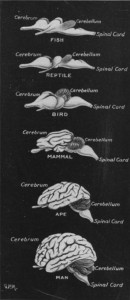I am not going to waste the gift of your attention on the question of whether our brain tripled in size in the last 2 million years in order to enable us to obtain sufficient food for survival. Obtaining food is the first and most important stage in any animal’s survival and therefore likely the major reason most times evolution takes place in a species.
The more interesting question, in my opinion, is whether the human brain grew so much in order to enable us to obtain a wider range of foods or to more efficiently obtain a specific type of food. In other words was versatility or specialization the reason for the human brain unprecedented expansion.
The champion of the versatility hypothesis is Peter Ungar who specializes in Craniodental analysis. In a 2006 paper he (together with Frederick Grine and Mark Teaford) proposed a “Dietary Versatility as an Adaptive Strategy”. The paper says that:”Craniodental adaptations and material culture would have allowed early Homo, and especially H. erectus, to eat a broader spectrum of foods than could earlier hominins.”
We (Ben-Dor et al) argued that Homo erectus was not unrestricted in his diet composition and had an obligated fat requirement. We further argued that the brain of post H. erectus humans got bigger in order to maintain specialization in hunting of fat rich animals in the face of diminishing supply.
Evolution can be viewed as dynamic solutions to problems in optimization of systems design. Biological systems are required to provide optimal solutions to various conflicting contemporaneous requirements, necessary for survival under changing environmental conditions.
Humans, for example, need to be able to move efficiently, energy wise, in order to track and hunt sufficient number of animals, for which purpose being lightweight would be advantageous but we also need to store energy for times of food shortage with the cost of adding to our weight, reducing the energy efficiency of locomotion. So evolutionary design has to strike a compromise (and this is where the thrifty gene hypothesis becomes problematic but we shall leave that to another post).
A May 2012 Science paper by Robert Schuetz et al on the optimization principles of evolution in E. coli may contribute an interesting point of view to the relative validity of the versatility vis. specialization explanation for our large brain size.
The authors tried to find out which principles of design guided the evolution of E. coli metabolism. From Science’s introduction to the paper: “As a pathway evolves, there are likely to be competing objectives that must be satisfied. Key objectives for the bacterium were strong performance under a given environmental condition, balanced by a requirement for adaptability – minimizing the adjustments required to respond to changed conditions.” Or, in the language of the abstract: “we propose that flux states evolve under the trade-off between two principles: optimality under one given condition and minimal adjustment between conditions”. “Condition” in this paper means the relative greater availability of a certain metabolic substrate (glucose or/and acetate).
So we have a metabolic system that is optimized to work with one type of energy source (food) but its optimum is limited to a degree by the need for adaptability to alternative energy source at a minimized cost should the need arise.
It may be a long shot but my take is that like E. coli‘s metabolism, our metabolic pathways have evolved to be optimal under one given environmental conditions namely one that prevailed during the millions of years when fat (SCFA) from fiber fermentation and later, meat and fat from hunted herbivores, were our major energy sources. This optimality was limited by the need to retain adaptability to alternative conditions, namely when meat and fat is in short supply “minimizing the adjustments required to respond to changed conditions”,
Since humans are more complicated than E. coli the initial optimization may have beeen to a certain ratio of animal to plant food but that an optimum is multi component does not imply that versatility is the principle guideline.
Versatility comes at a cost. The E. coli experiment teaches us that evolution favors optimality as the primal objective but is giving up a certain degree of optimality in order to gain versatility.
How much have we paid in optimality in order to retain versatility is not really important. It’s a done deal and we can’t change it. What is important to know is what the costs of “adjustment between conditions” are. They are “minimized” but what are they?
One conclusion is obvious – the fact that we are versatile in our ability to extract energy from food doesn’t mean that we should strive to eat a wide variety of foods. Coping mabolically with variety is an evolutionary headache.







 I am a Ph.D. in archaeology, affiliated with the department of Archaeology of Tel Aviv University. I research the connection between human evolution and nutrition throughout human prehistory.
I am a Ph.D. in archaeology, affiliated with the department of Archaeology of Tel Aviv University. I research the connection between human evolution and nutrition throughout human prehistory.
